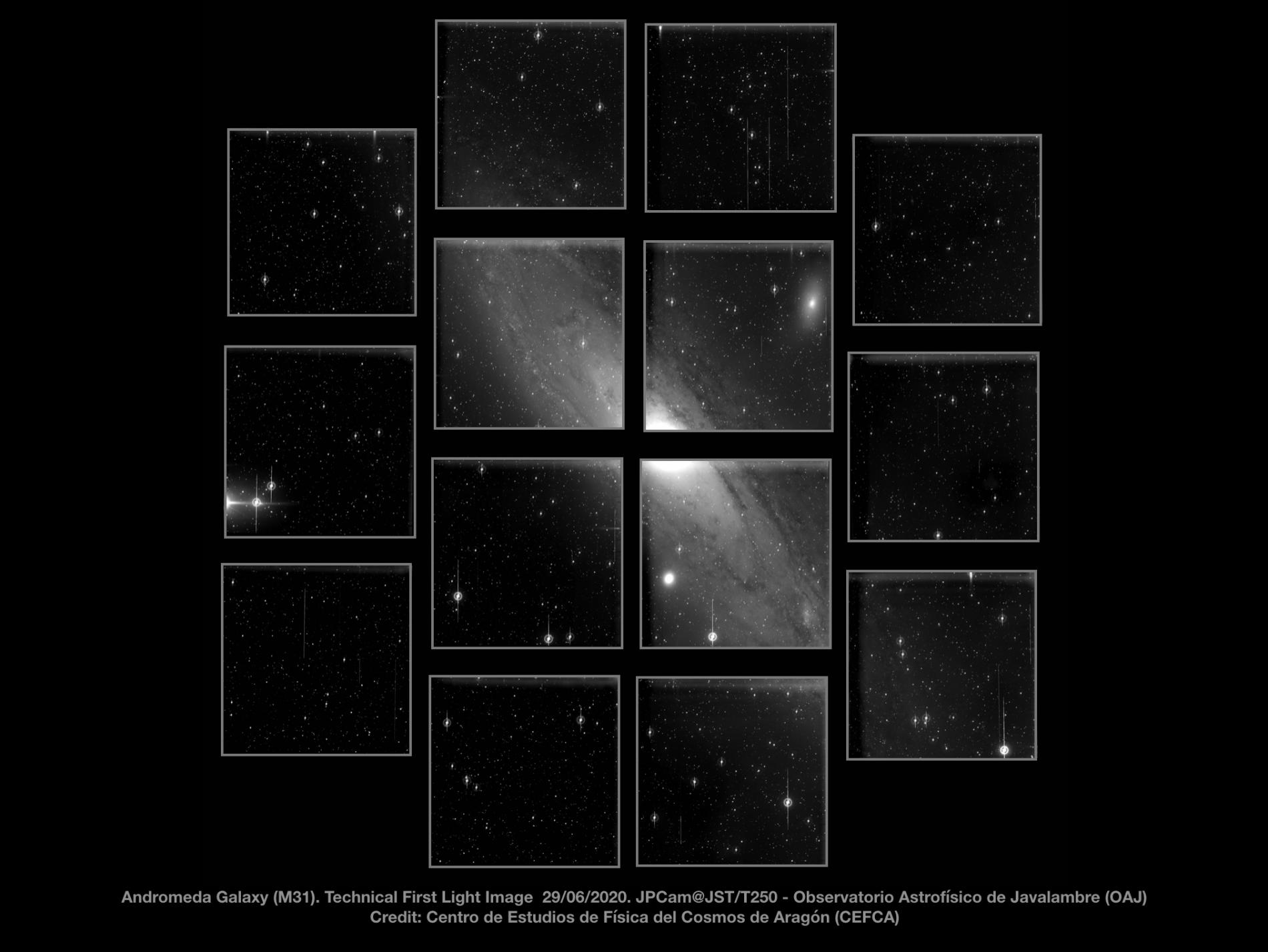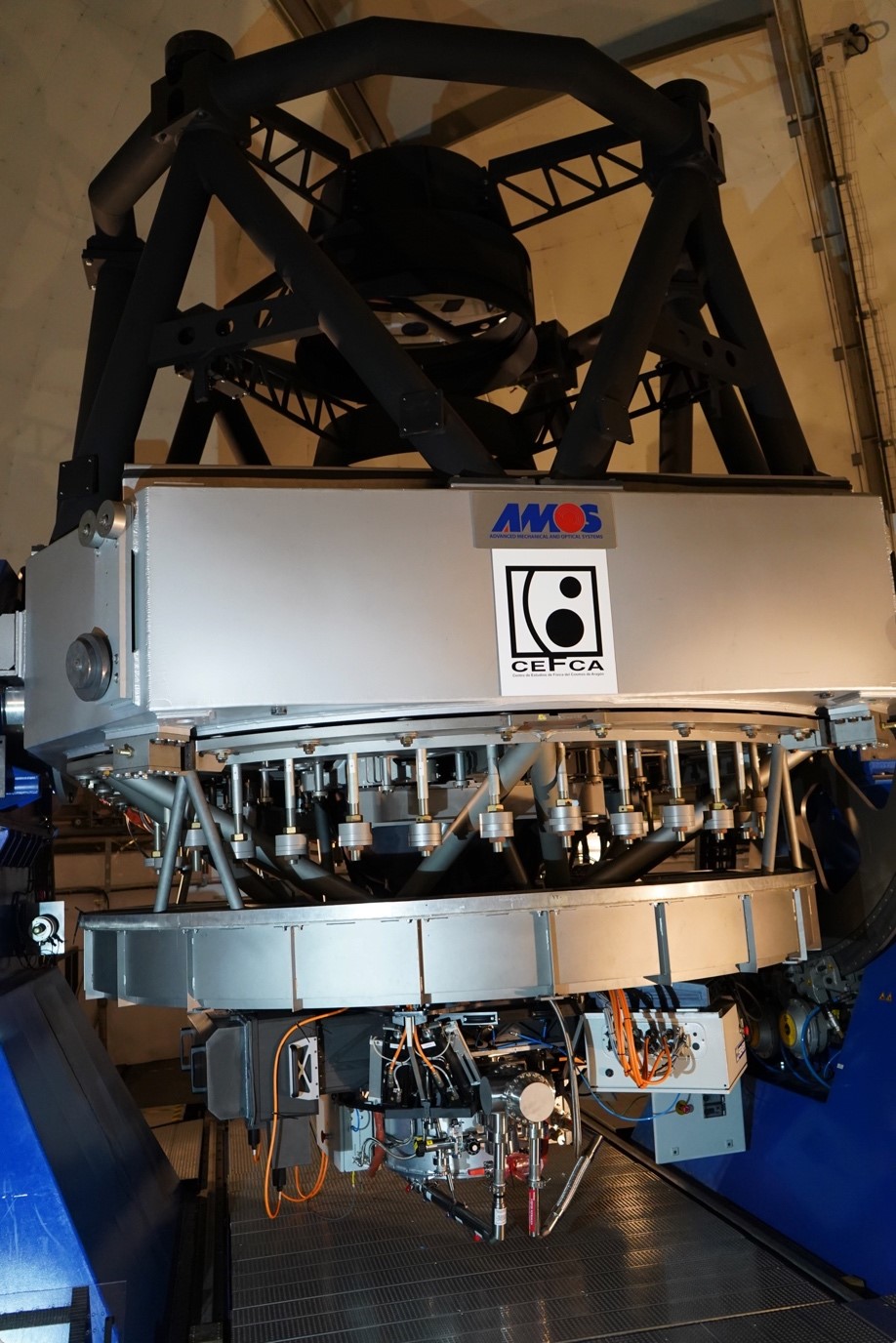First technical light of the JPCam panoramic camera at the Javalambre Astrophysical Observatory
The start up of operations of the instrument represents the technological culmination of the Javalambre Astrophysical Observatory in Teruel.
This instrument is key for J-PAS, an unprecedented future extragalactic mapping led by an international consortium of which the IAA-CSIC is a member.
The JPCam camera, installed last June in the 2.5m Javalambre Survey Telescope (JST/T250) at the Javalambre Astrophysical Observatory (OAJ), made its first technical light on the night of June 29th, successfully obtaining its first images of the sky.

Image taken during the first technical light of the JPCam camera installed in the JST/T250 of the Javalambre Astrophysical Observatory. It shows the Andromeda Galaxy (M31) located 2.5 million light years away, and which has an angular diameter in the sky equivalent to seven full moons, being the largest extragalactic object that can be seen with the naked eye in the northern hemisphere. Credit: Centro de Estudios de Física del Cosmos de Aragón (CEFCA)
In the field of professional astrophysics, the "first light" of an astronomical telescope or instrument is the moment when, for the first time, it is pointed towards the sky and photons from stars or galaxies are collected and recorded. The purpose of the first technical light is to verify that the essential technical performance of the telescope or instrument is as specified in the design phase.
JPCam is the second largest astronomical camera in the world, with more than 1.2 billion pixels distributed in a mosaic of 14 scientific detectors working in high vacuum and at 110º below zero. Weighing more than one and a half tons, it provides scientific image quality with high resolution and stability throughout its large field of view. Proof thereof is the fact that in order to view one of its images at full scale it would be necessary to join up to 570 Full HD monitors
These features, together with a set of 56 filters covering the entire optical range of the spectrum, make JPCam one of the most powerful astronomical cameras in the world, specifically designed to perform large mapping of the sky, such as J-PAS (Javalambre Physics of the Accelerating Universe Astrophysical Survey), a three-dimensional map of the Northern Hemisphere sky that will cover an area of 8. 500 square degrees and will generate 2.5 petabytes of scientific data with hundreds of millions of galaxies, and to which JPCam will dedicate most of its observation time.
"J-PAS will be a key mapper in the study of the evolution of galaxies. The innovative design of JPCam and the filter system will allow us to estimate the properties of a wide variety of galaxy populations and to infer their cosmic evolution as never before", says Pr. Rosa González, researcher at the Instituto de Astrofísica de Andalucía, and coordinator of the J-PAS Scientific Group on Galaxy Evolution - "J-PAS will offer us for the first time a complete 3D view of the Universe".
JPCam has been designed by CEFCA and by members of the J-PAS scientific collaboration of whose international consortium led by CEFCA, the IAA-CSIC is part together with the Brazilian institutions of the National Observatory of Rio de Janeiro and the University of Sao Paulo.
"The IAA-CSIC has been participating in J-PAS since the project was first conceived, which was born as a groundbreaking idea promoted by previous colleagues at the institute to attack pending problems in cosmology and the evolution of galaxies, as well as in stellar physics and the Solar System; objectives that will surely place Spanish astronomy at the frontier of knowledge", says Dr. José Vílchez, a researcher at the IAA-CSIC and a member of the International Board of the J-PAS collaboration and its Operations Committee. "This first technical image shows us the unprecedented capacity of JPCam to make the ambitious J-PAS mapping a reality"
In addition to J-PAS, at least 20% of JPCam time will be offered to the international scientific community, as part of the open time offered by the OAJ as ICTS so that researchers can access the use of their infrastructures through regular calls for competitive observation time. The data collected by JPCam will be of great importance for different fields of astrophysics. They will allow the study of questions such as the nature of dark energy or the history of the expansion of the Universe over the last 10,800 million years, as well as the formation and evolution of galaxies, the structure and history of our Galaxy, the Milky Way, or the systematic study of asteroids in our Solar System.
The investment made in JPCam has exceeded 10 million euros, mainly from the Teruel Investment Fund, ERDF funds and the aforementioned Brazilian institutions.

JPCam installed at the Cassegrain focus of the JST/T250 telescope at the Javalambre Astrophysical Observatory. Credit: Centro de Estudios de Física del Cosmos de Aragón (CEFCA)).
With the first JPCam technical light, the phase of the camera commissioning in the telescope begins, during which the last work of fine-tuning and adjustment of the instrument in the JST/T250 will be carried out. In the next months, the team of scientists and engineers of CEFCA will carry out a set of verifications, adjustments and optimization of the different systems of JPCam, of the telescope and of the infrastructure of management and analysis of data with the aim of reaching their optimal performances. "The success of this phase is fundamental to guarantee the maximum scientific return of JPCam, of the JST/T250 and of the OAJ itself", explains Dr. Antonio Marín-Franch, researcher at the Centro de Estudios de Física del Cosmos de Aragón (CEFCA), responsible for the OAJ and Project manager of JPCam.
About the CEFCA and the OAJ
The Centro de Estudios de Física del Cosmos de Aragón (CEFCA) is a research centre founded in 2008 and located in Teruel, dependent on the Department of Science, University and Knowledge Society of the Government of Aragon. The main lines of research of CEFCA, which is an Associated Unit of the CSIC, are Cosmology and Galaxy Formation and Evolution. CEFCA's activities include the development, operation and scientific exploitation of the Spanish Singular Scientific and Technical Infrastructure (ICTS) Javalambre Astrophysical Observatory (OAJ), which is equipped with two telescopes specially designed to carry out large mappings of the sky that are unique in the world. In addition, CEFCA is leading the J-PAS project, a multinational consortium that will carry out a map of the Universe observable from Javalambre that is unprecedented in international astrophysics. CEFCA website
About the IAA-CSIC
The IAA-CSIC, located in Granada, is a centre of excellence Severo Ochoa belonging to the Spanish National Research Council (CSIC). Its objective is to deepen the knowledge of the cosmos by doing research in astrophysics and cutting-edge space science, promoting technological development and disseminating its research among the scientific community and the general public. Its lines of research cover each and every one of the main areas of modern astrophysics, from quantum gravity to the Solar System, including the evolution of galaxies, cosmology, the structure of our Galaxy and extrasolar planets. The centre manages the Sierra Nevada Observatory and scientifically co-manages the Calar Alto Observatory, and leads cutting-edge technological developments for space missions and observatories on Earth. The IAA-CSIC is one of the four members of the J-PAS consortium. IAA-CSIC web page
About the ICTS
The Singular Scientific and Technical Infrastructures (ICTS) are large facilities, resources, equipment and services, unique in their kind, which are dedicated to cutting-edge, top-quality research and technological development, as well as to promoting the transmission, exchange and preservation of knowledge, technology transfer and innovation. The ICTS are unique or exceptional in their kind, and whose importance and strategic nature justifies their availability to the entire R+D+i collective. The ICTS have three fundamental characteristics: they are publicly owned infrastructures, they are unique and they are open to competitive access. ICTS website
CONTACT IAA-CSIC - Dr. José Manuel Vílchez, IAA-CSIC, 616 73 96 91, jvm@iaa.es
CONTACT CEFCA -Dr. Antonio Marín, CEFCA, 978 221 266 ext. 1125, amarin@cefca.es
Instituto de Astrofísica de Andalucía (IAA-CSIC)
Unidad de Divulgación y Comunicación
Silbia López de Lacalle - sll[arroba]iaa.es - 958230676
https://www.iaa.csic.es
https://divulgacion.iaa.csic.es

